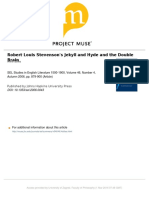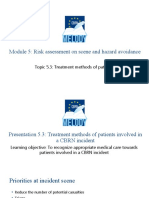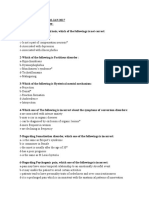Professional Documents
Culture Documents
Performance of Serum Tube Agglutination Test and Enzyme-Linked Immunosorbent Assay IgG and IgM Tests For Diagnosis of Human Brucellosis Among Employees of Widam Slaughter Establishments
Original Title
Copyright
Available Formats
Share this document
Did you find this document useful?
Is this content inappropriate?
Report this DocumentCopyright:
Available Formats
Performance of Serum Tube Agglutination Test and Enzyme-Linked Immunosorbent Assay IgG and IgM Tests For Diagnosis of Human Brucellosis Among Employees of Widam Slaughter Establishments
Copyright:
Available Formats
Volume 4, Issue 8, August – 2019 International Journal of Innovative Science and Research Technology
ISSN No:-2456-2165
Performance of Serum Tube Agglutination Test and
Enzyme-Linked Immunosorbent Assay IgG and IgM
Tests for Diagnosis of Human Brucellosis among
Employees of Widam Slaughter Establishments
Maisan Ahmed1; Samirha Hamid Ablelrahman2; Adam Dawoud Abakar3, Yousif Abdelhameed Mohammed4,
Dr. Elmoubasher Abu Baker Abd Farag5, Wassan Abdullah Al-baker1, Hamad Eid Al-Romaihi5, Mohamed Hamad Al-Thani6
1
Food Safety Department, Ministry of Public Health, Qatar
2
Blue Nile National Institute for Communicable Diseases, University of Gezira
3
Department of Medical Parasitology, Faculty of Medical Laboratory Sciences Gezira
4
National Cancer Institute, University of Gezira,
5
Communicable Diseases Control Program, Ministry of Public Health, Qatar
6
Public Health Department, Ministry of Public Health, Qatar
Abstract:- participants were male (99.2%, n=129) and 77.7% (n=
101) were married. Overall, 73.1% (n=95) were from
Objectives South East Asian Countries, followed by 26.1% (n=34)
Brucellosis is reported as important food borne from Arab African Countries. ELISA IgG and IgM has
zoonotic infection worldwide. There are number of sensitivity (83.4% and 16.67%) respectively and
techniques utilize to detect the presence of Brucella specificity (93.3% and 99.13%).
species in human sera and these techniques have different
levels of specificity and sensitivity and the purpose of this Conclusion
study is to assess the Diagnostic Performance of Serum Conclusion that ELISA IgM tests should not be used
Tube Agglutination Test and Enzyme-Linked to confirm brucellosis.
Immunosorbent Assay IgG and IgM Tests for Diagnosis
of Human Brucellosis among the study group at Widam Keywords:- Brucellosis, STAT, ELISA, IgG and IgM, Qatar.
slaughter establishments.
I. INTRODUCTION
Methods
A total of 141 human sera samples were collected Brucellosis is a non-endemic disease in Qatar and has a
from large animals’ slaughter establishments in Qatar, small incidence compared to other EMR nations. Between
namely, Abu Hamour slaughter establishment, Alshamal 2004 and 2012, the prevalence of brucellosis has decreased
Slaughter establishment, Muaither slaughter where the peak prevalence occurred in 2006 (4.2 cases per
establishment, Abu Hamour slaughterhouse for the 100,000 residents). The transmission route was found to be
Public, Um Salal slaughterhouse, AlMazroua consumption of raw milk and milk products at a rate of
slaughterhouse, Al Rayan slaughterhouse, Al shahaniya 41.7% of the study group get infected by consumption of raw
slaughterhouse from August 2017 to September 2017. The milk or milk products, and 12.5% of the study group acquire
samples were tested by serological tests, serum tube the infection via contact with animals or animals’ parts
agglutination test (STAT), and enzyme-linked infected with brucella. An outbreak of human brucellosis due
immunosorbent assay (ELISA) (immunoglobulin M to consumption of raw camel milk, was reported in Qatar in
[IgM] and immunoglobulin G [IgG]). 14 members of a family live in the rural area of Qatar
(Garcell, 2016).
Results
130 participants were divided into two age groups Human brucellosis can be diagnosed by serologic tests
(18 - 45 and ≥ 46), in which, 82.3% were aged 18 – 45 and by blood cultures or by using both testing techniques.
years and 17.7% were aged ≥ 46 yrs. The age range Patients should be placed on treatment if bacteria brucella
across the samples was 18-68 years with a mean age of genes were identified (Al-Nassir, 2016).
38.35 Years (SD = 8.62). Additionally, the majority of the
IJISRT19AUG1010 www.ijisrt.com 879
Volume 4, Issue 8, August – 2019 International Journal of Innovative Science and Research Technology
ISSN No:-2456-2165
Serological tests such as serum tube agglutination test and numbered as 1-8. The test cylinder marked with 8 was
(STAT), Rose Bengal plate test (RBPT), enzyme-linked taken for negative control. The primary test cylinder was
immunosorbent assay (ELISA), are among the laboratory topped off with 1.9 ml phenol saline, and other 7 test
testing techniques used for diagnosis of human brucellosis. cylinders were topped off with 1 ml phenol saline. Next, 0.1
Among these also is the molecular test technique like ml test serum was taken to the primary test cylinder to get
polymerase chain reaction (PCR) and blood culture technique 1/20 weakening. After that from first test tube, 1 ml
to isolate brucella organism. weakened serum test was moved to the second test cylinder,
and this procedure was rehashed from the second to seventh
There is a lack of serological test technique that can test cylinders to get 1/40, 1/80, 1/160, 1/320, 1/640, and
solely confirm the diagnosis of brucellosis. However, PCR is 1/1280 weakening. Next, 1 drop (50 µL) of antigen was
considered as an excellent choice to test for human added to each test tube alongside negative control and
brucellosis. PCR is used as sign to foresee the development blended. From that point forward, all the test cylinders were
of the disease (Prakash, 2012; Mangalgi, 2012). Most of the kept in hatchery at 37°C for 24 hrs. An immune response titer
serological tests used at laboratories are not particularly of 1:160 or more was viewed as positive for brucellosis.
useful in delivering an appropriate sensitivity and specificity
for brucella organism. For instance, Enzyme-linked ELISA
immunosorbent assay (ELISA) technique which detect The Brucella ELISA test was performed utilizing a
immunoglobulin G (IgG) has high sensitivity (Vakili, 2010) business pack (Immunolab immunoglobulin M [IgM] and
however, has low specificity (Amirzargar, 2009) immunoglobulin G [IgG], Germany), and the method of the
test was trailed by the unit guidance. From the start
This study was conducted to compare STAT with microtiter, wells (which are covered with Brucella antigen
ELISA IgG and IgM tests for diagnosis of human brucellosis (B. abortus strain, w99) were topped off with 100 µL each of
among in Widam slaughter establishments. the diluted (1:101) samples together with ready to use
standards and controls except one well which was used for
II. METHODS the substrate blank. This was followed by placing the plate at
room temperature for 1 hour. Plates were then washed with
Study Design wash buffer and 100 µL of enzyme conjugate was pipetted
Cross sectional study was conducted at Widam into each well. Plates were then covered with foil and
slaughter establishments, to assess Diagnostic Performance incubated at room temperature for 30 minutes. Wells were
of Serum Tube Agglutination Test and Enzyme-Linked washed with diluted wash buffer. 100 µL of substrate
Immunosorbent Assay IgG and IgM Tests for the Diagnosis solution was pipetted into each well. Plates were placed in
of Human Brucellosis among the study focus group from full darkness and incubated at room temperature for 20
Widam slaughter establishments. minutes. Finally, 100 µL of stop solution was pipetted to
each of the wells to halt reaction. Optical density was then
Blood Samples measured using a photometer at 450 mm.
A total of 141 human sera samples were collected from
different Qatar slaughters, namely, Abu Hamour slaughter Statistical Analysis
establishment, Alshamal Slaughter establishment, Muaither The sensitivity, specificity and the kappa value of the
slaughter establishment, Abu Hamour slaughterhouse for the test were calculated using MedCal (16) software at 95%
Public, Um Salal slaughterhouse, AlMazroua slaughterhouse, confidence interval. A p-value <0.05 was considered as
Al Rayan slaughterhouse, Al shahaniya slaughterhouse. statistically significant.
Animals awaiting slaughter are kept in pens located outside
of the main slaughter building. Veterinary care is provided to IV. RESULTS
these animals for the entire period they spent in pens.
Livestock caretakers are assigned to feed and take care of 130 participants were divided into two age groups (18 -
these animals until they are sent to the slaughter est. for 45 and ≥ 46), in which, 82.3% were aged 18 – 45 years and
slaughter. 17.7% were aged ≥ 46 yrs. The age range across the samples
was 18-68 years with a mean age of 38.35 Years (SD = 8.62).
III. SEROLOGICAL TESTS Additionally, the majority of the participants were male
(99.2%, n=129) and 77.7% (n= 101) were married. Overall,
STAT 73.1% (n=95) were from South East Asian Countries,
STAT was performed utilizing a business pack [Tulip followed by 26.1% (n=34) from Arab African Countries table
Diagnostics (p) Ltd. Goa, India]. The unit contains prepared (1).
to utilize institutionalized explicit antigen suspensions of
Brucella having explicit reactivity toward antibodies to B. The levels of IgG & IgM antibodies were assessed by
abortus and B. melitensis. The test was performed by the commercial ELISA kits in the sera of 130 participants
organization rules. From the start, 8 test cylinders were taken working at Widam slaughter establishments in Qatar. The
IJISRT19AUG1010 www.ijisrt.com 880
Volume 4, Issue 8, August – 2019 International Journal of Innovative Science and Research Technology
ISSN No:-2456-2165
seroprevalence of Brucellosis is shown in table (2). The to the duration of the job and different establishments or
overall Brucella IgG and IgM was 9.3% (n=12) and 3.84% collection sites, was not significantly different. The
(5), respectively. prevalence of Brucella-IgG and IgM among workers from
South East Asian countries was higher (5.38%, n = 7) than
According to age groups, the prevalence of IgG (8.7%, workers from Arab and African countries 3.84% (n = 5).
n = 11) and IgM (3.1%, n = 4) was highest in the age group Among the South East Asian and Arab & African workers,
<45 years, however, did not differ significantly according to Brucella-IgG antibodies were detected higher in workers
patient age (P= 0.472 and 0.819, respectively) (Table 3). originating from India (4.61%, n = 6) and Egypt (3.1%, n=4).
Furthermore, the seroprevalence of Brucella-IgG (3.6%, n = Additionally, IgM positivity was equal in both Indian and
9), and IgM (3.8%, n=5) was highest among married workers Nepalese workers (1.53%, n=2 in each) (table 2).
(5.4%, n = 5) and lowest among single, but the difference
was not statistically significant (P = 0.112 and 0.318, Furthermore, based on IgG/IgM ELISA and tube
respectively). The Brucella-IgG seropositivity was higher agglutination test, we extended our analysis to evaluate and
among workers with primary (3.1%, n=4) and secondary compare the test sensitivity and specificity using receiving
school (3.8%, n=5) education and slaughtering & processing operating characteristic. and found higher AUC performance
occupation (6.15%, n=8), but had no significant association. in ELISA IgG (0.886) and (0.902) when compared to B.
However, IgM positivity was slightly higher but had no abortus and B. melitensis (table 3 and 4). Whereas in case of
significant association among workers with illiterate & IgM, a low performance was noted which was equal to
primary education and livestock & slaughtering & processing (0.507) and (0.508) when compared to B. abortus and B.
occupation. Additionally, the level of IgG and IgM according melitensis (Table 5 and 6; Figure 1 and 2)
Frequency Percentage
Male 129 99.2
Female 1 0.8
18 – 45 Years 107 82.3
> 45 Years 23 17.7
South East Asian Countries 95 73.1
Arab African Countries 35 26.9
Married 101 77.7
Single 29 22.3
Table 1:- Demographic data of 130 workers of Widam Slaughter Establishments in Qatar
IGG P. Value IGM P. Value
Equivocal Positive Negative Equivocal Positive Negative
Positive Titer 0 5 1 0.000 1 1 4 0.002
Negative Titer 9 7 108 1 4 119
Total 9 12 109 2 5 123
Table 2:- Brucella Abortus and ELISA IgG and IgM
IGG P. Value IGM P. Value
Equivocal Positive Negative Equivocal Positive Negative
Positive Titer 0 6 1 0.000 1 1 5 0.006
Negative Titer 9 6 108 1 4 118
Total 9 12 109 2 5 123
Table 3:- Brucella Melitensis and ELISA IgG and IgM
IJISRT19AUG1010 www.ijisrt.com 881
Volume 4, Issue 8, August – 2019 International Journal of Innovative Science and Research Technology
ISSN No:-2456-2165
IgG IgM V. DISCUSSION
Sensitivity 83.33 16.67
Specificity 93.31 99.13 Brucellosis continues to be a disease of high risk to
AUC 0.886 0.507 public health in developing nations (Khan, 2018). The
Weighted Kappaa 0.524 0.138 disease imparks considerable effects and endemicity, as
Table 5:- Sensitivity and specificity of IgG and IgM cause of acute febrile illness, in most Middle east countries
according to Brucella abortus (a Linear weight) among human and livestock productivity [McDermott, 2013;
Dean, 2012]. The prevalence of disease varies greatly from
country to country and across different regions with in a
country (Acha and Szyfers, 2001). The present study aimed
to compare STAT with ELISA IgG and IgM tests for
diagnosis of human brucellosis among in Widam slaughter
establishments, In this study, the overall seroprevalence of
human brucellosis among slaughterhouse workers in Qatar is
9.3%. In earlier reports from neighboring countries, the
seroprevalence rate shows a seroprevalence of 8.6% in Saudi
Arabia, 11.4% in Sudan, 6.26 % in Egypt and 6.2% in
Yemen (Rahamathulla, 2019; Tamador EA et al., 2014;
Nawal, 2012; Al-Haddad, 2013). Worldwide, seroprevalence
of human brucellosis is more common in males than in
females [Al-Nassir, 2016]. In addition, young adult males
predominate in most series of patients with brucellosis
compiled in areas of endemic disease [Al-Nassir, 2016]. In
this study, we observed brucellosis was more amongst male
Fig 1:- Sensitivity and specificity of IgG and IgM according this is due to the fact that male is more involved in the risk of
to Brucella abortus occupational exposure due to their direct contact with
animals, meat, and milk products. Occupational exposure to
IgG IgM animals likely plays an important role in the enhanced
Sensitivity 85.71 14.29 vulnerability of men to the development of brucellosis. It is
Specificity 94.74 99.12 unknown whether the increased risk manifested by males, is
AUC 0.902 0.508 additionally influenced by aspects of personal hygiene,
Weighted Kappaa 0.603 0.123 immunologic factors, or other circumstances. (Al-Nassir,
Table 6:- Sensitivity and specificity of IgG and IgM 2016). Similar to our findings, other studies had shown a
according to Brucella melitensis (a Linear weight) male predominance (Asad, 2012; Al-Tawfiq, 2009).
In this study, 4.61% of the individuals were Indian
nationals and the highest percentage of IgG and IgM
recorded (8.7% and 3.1%, respectively) was in the age group
of <45 years. This may be due to the fact that people in this
working age group are more in contact with domestic animals
like cattle breeding, farming, butchering and consume raw
milk and dairy products. In contrast to previous studies, these
were not identified as major risk factors for brucellosis in this
study (Memish, 2001; Al-Haddad, 2013). In addition,
duration of work period also didn’t show a significant role in
getting the infection.
In this study, which employed Brucella SAT as the
diagnostic reference standard, the ELISA IgG sensitivity
were found to have (83.4% ) compared to SAT, this result is
lower than what has been reported in the literature (Osoba,
2001; Araj, 1986; De Klerk & Anderson, 1985; Araj &
Fig 2:- Sensitivity and specificity of IgG and IgM according Kaufmann, 1989; Sippel, 1982). and higher than results
to Brucella melitensis obtained from (Welch and Litwin, 2010) and (Memish, 2002)
Contrary to previous studies ELISA IgM retrieves low
sensitivity (16.67%) lower than what has been reported in the
IJISRT19AUG1010 www.ijisrt.com 882
Volume 4, Issue 8, August – 2019 International Journal of Innovative Science and Research Technology
ISSN No:-2456-2165
literature (Osoba, 2001; Araj, 1986; De Klerk & Anderson, [10]. Mangalgi SS, Sajjan GA, Mohite TS. (2012)
1985; Araj & Kaufmann, 1989; Sippel, 1982; Welch and Brucellosis: A cause for pyrexia of unknown origin. Int
Litwin, 2010; Memish, 2002). ELISA IgG and IgM has J Biol Med Res;3(3):2054-5.
higher specificity (93.3% and 93.1%) this finding in [11]. McDermott J, Grace D, Zinsstag J. (2013) Economics
agreement with (Osoba, 2001; Araj, 1986; De Klerk & of brucellosis impact and control in low-income
Anderson, 1985; Araj & Kaufmann, 1989; Sippel, 1982; countries. Revue Scientifique et Technique
Welch and Litwin,2010; Memish, 2002). (International Office of Epizootics); 32: 249–261.
[12]. Memish, Z. A., Almuneef, M., Mah, M. W., Qassem, L.
ACKNOWLEDGEMENTS A., & Osoba, A. O. (2002). Comparison of the Brucella
Standard Agglutination Test with the ELISA IgG and
The author would like to express her gratitude to the IgM in patients with Brucella bacteremia. Diagnostic
managers of Widam Food Company and all individuals who microbiology and infectious disease, 44(2), 129-132.
volunteer to participate in this study. [13]. Osoba, A. O., Balkhy, H., Memish Z., Khan M. Y., et
al. (2001). Diag- nostic value of Brucella Elisa IgG and
REFERENCES IgM in bactremic and non- bactremic patients with
Brucellosis. Journal of Chemotherapy, Suppl 1,54 –59.
[1]. Al-Haddad AM, Al-Madhagi AK, Talab AA, Al- [14]. Prakash, P., Bhansali, S., Gupta, E., Kothari, D.,
Shamahy HA. The prevalence of human brucellosis in Mathur, A., & Ambuwani, S. (2012). Epidemiology of
three selected areas in Al-Dala’a governorate, Yemen. brucellosis in high risk group & PUO patients of
Faculty Sci Bull. 2013;25:61-71. Western-Rajasthan. National Journal of Community
[2]. Aloufi A, Memish Z, Assiri A, McNabb S: Trends of Medicine, 3(1), 61-65.
reported human cases of brucellosis, Kingdom of Saudi [15]. Rahil A, Othman M, Ibrahim W, Mohamed M (2014):
Arabia, 2004-2012. J Epidemiol Glob Health. 2016, Brucellosis in Qatar: a retrospective cohort study. Qatar
6:11-18. Med J., 1:4. 10.5339%2Fqmj.2014.4.
[3]. Al-Tawfiq JA, Abukhamsin A. A 24-year study of the [16]. Sippel, J. E., El Masry, N. A., & Farid, Z. (1982).
epidemiology of human brucellosis in a health-care Diagnosis of human Brucellosis with ELISA. Lancet, ii,
system in Eastern Saudi Arabia. J Infect Public Health. 19 –21.
2009;2(2):81-85. [17]. Vakili, Z., Momen Heravi, M., Sharif, A. R., &
[4]. Amirzargar A, Hassibi M, Maleknejad P, et al. Masoomi, M. (2010). Sensitivity and specificity of
Comparison of diagnostic methods in hospitalized ELISA test in diagnosis of brucellosis. Kowsar Med
patients with brucellosis in Iran. Inf Dis Clin Pract. J, 15(2), 95-98.
2009;17(4):239-242. [18]. Welch, R. J., & Litwin, C. M. (2010). A comparison of
[5]. Araj, G. F., Lulu, A. R., Mustafa, M. Y., & Khateeb, Brucella IgG and IgM ELISA assays with agglutination
M. I. (1986). Evaluation of ELISA in the diagnosis of methodology. Journal of clinical laboratory
acute and chronic Brucellosis in human beings. Journal analysis, 24(3), 160-162.
of Hygiene (Cambridge), 97, 457– 469.
[6]. Araj, G. F., & Kaufmann, A. F. (1989). Determination
by enzyme-linked immunoabsorbent assay of
immunoglobulin G (IgG), IgM and IgA to Brucella
melitensis major outer membrane proteins and whole-
cell heat-killed antigens in sera of patients with
Brucellosis. Journal of Clinical Microbiology, 1909 –
1912.
[7]. De Klerk, E., & Anderson, R. (1985). Comparative
evaluation of the enzyme-linked immunosorbent assay
in the laboratory diagnosis of Brucellosis. Journal of
Clinical Microbiology, 21 (3), 381–386.
[8]. Garcell H, Garcia E, Pueyo P, Martín I, Arias AV,
Alfonso Serrano (2016), RN: Outbreaks of brucellosis
related to the consumption of unpasteurized camel milk.
J Infect Public Health., 4:523-527.
10.1016/j.jiph.2015.12.006.
[9]. Khan, M. Z., & Zahoor, M. (2018). An Overview of
Brucellosis in Cattle and Humans, and its Serological
and Molecular Diagnosis in Control
Strategies. Tropical medicine and infectious
disease, 3(2), 65. doi:10.3390/tropicalmed3020065
IJISRT19AUG1010 www.ijisrt.com 883
You might also like
- Advancing Healthcare Predictions: Harnessing Machine Learning for Accurate Health Index PrognosisDocument8 pagesAdvancing Healthcare Predictions: Harnessing Machine Learning for Accurate Health Index PrognosisInternational Journal of Innovative Science and Research TechnologyNo ratings yet
- Diabetic Retinopathy Stage Detection Using CNN and Inception V3Document9 pagesDiabetic Retinopathy Stage Detection Using CNN and Inception V3International Journal of Innovative Science and Research TechnologyNo ratings yet
- Comparatively Design and Analyze Elevated Rectangular Water Reservoir with and without Bracing for Different Stagging HeightDocument4 pagesComparatively Design and Analyze Elevated Rectangular Water Reservoir with and without Bracing for Different Stagging HeightInternational Journal of Innovative Science and Research TechnologyNo ratings yet
- Design, Development and Evaluation of Methi-Shikakai Herbal ShampooDocument8 pagesDesign, Development and Evaluation of Methi-Shikakai Herbal ShampooInternational Journal of Innovative Science and Research Technology100% (3)
- Terracing as an Old-Style Scheme of Soil Water Preservation in Djingliya-Mandara Mountains- CameroonDocument14 pagesTerracing as an Old-Style Scheme of Soil Water Preservation in Djingliya-Mandara Mountains- CameroonInternational Journal of Innovative Science and Research TechnologyNo ratings yet
- Cyberbullying: Legal and Ethical Implications, Challenges and Opportunities for Policy DevelopmentDocument7 pagesCyberbullying: Legal and Ethical Implications, Challenges and Opportunities for Policy DevelopmentInternational Journal of Innovative Science and Research TechnologyNo ratings yet
- The Impact of Digital Marketing Dimensions on Customer SatisfactionDocument6 pagesThe Impact of Digital Marketing Dimensions on Customer SatisfactionInternational Journal of Innovative Science and Research TechnologyNo ratings yet
- The Utilization of Date Palm (Phoenix dactylifera) Leaf Fiber as a Main Component in Making an Improvised Water FilterDocument11 pagesThe Utilization of Date Palm (Phoenix dactylifera) Leaf Fiber as a Main Component in Making an Improvised Water FilterInternational Journal of Innovative Science and Research TechnologyNo ratings yet
- Dense Wavelength Division Multiplexing (DWDM) in IT Networks: A Leap Beyond Synchronous Digital Hierarchy (SDH)Document2 pagesDense Wavelength Division Multiplexing (DWDM) in IT Networks: A Leap Beyond Synchronous Digital Hierarchy (SDH)International Journal of Innovative Science and Research TechnologyNo ratings yet
- Formulation and Evaluation of Poly Herbal Body ScrubDocument6 pagesFormulation and Evaluation of Poly Herbal Body ScrubInternational Journal of Innovative Science and Research TechnologyNo ratings yet
- Auto Encoder Driven Hybrid Pipelines for Image Deblurring using NAFNETDocument6 pagesAuto Encoder Driven Hybrid Pipelines for Image Deblurring using NAFNETInternational Journal of Innovative Science and Research TechnologyNo ratings yet
- Electro-Optics Properties of Intact Cocoa Beans based on Near Infrared TechnologyDocument7 pagesElectro-Optics Properties of Intact Cocoa Beans based on Near Infrared TechnologyInternational Journal of Innovative Science and Research TechnologyNo ratings yet
- Explorning the Role of Machine Learning in Enhancing Cloud SecurityDocument5 pagesExplorning the Role of Machine Learning in Enhancing Cloud SecurityInternational Journal of Innovative Science and Research TechnologyNo ratings yet
- A Survey of the Plastic Waste used in Paving BlocksDocument4 pagesA Survey of the Plastic Waste used in Paving BlocksInternational Journal of Innovative Science and Research TechnologyNo ratings yet
- A Review: Pink Eye Outbreak in IndiaDocument3 pagesA Review: Pink Eye Outbreak in IndiaInternational Journal of Innovative Science and Research TechnologyNo ratings yet
- Navigating Digitalization: AHP Insights for SMEs' Strategic TransformationDocument11 pagesNavigating Digitalization: AHP Insights for SMEs' Strategic TransformationInternational Journal of Innovative Science and Research TechnologyNo ratings yet
- Automatic Power Factor ControllerDocument4 pagesAutomatic Power Factor ControllerInternational Journal of Innovative Science and Research TechnologyNo ratings yet
- Hepatic Portovenous Gas in a Young MaleDocument2 pagesHepatic Portovenous Gas in a Young MaleInternational Journal of Innovative Science and Research TechnologyNo ratings yet
- Studying the Situation and Proposing Some Basic Solutions to Improve Psychological Harmony Between Managerial Staff and Students of Medical Universities in Hanoi AreaDocument5 pagesStudying the Situation and Proposing Some Basic Solutions to Improve Psychological Harmony Between Managerial Staff and Students of Medical Universities in Hanoi AreaInternational Journal of Innovative Science and Research TechnologyNo ratings yet
- Review of Biomechanics in Footwear Design and Development: An Exploration of Key Concepts and InnovationsDocument5 pagesReview of Biomechanics in Footwear Design and Development: An Exploration of Key Concepts and InnovationsInternational Journal of Innovative Science and Research TechnologyNo ratings yet
- The Effect of Time Variables as Predictors of Senior Secondary School Students' Mathematical Performance Department of Mathematics Education Freetown PolytechnicDocument7 pagesThe Effect of Time Variables as Predictors of Senior Secondary School Students' Mathematical Performance Department of Mathematics Education Freetown PolytechnicInternational Journal of Innovative Science and Research TechnologyNo ratings yet
- Mobile Distractions among Adolescents: Impact on Learning in the Aftermath of COVID-19 in IndiaDocument2 pagesMobile Distractions among Adolescents: Impact on Learning in the Aftermath of COVID-19 in IndiaInternational Journal of Innovative Science and Research TechnologyNo ratings yet
- Enhancing the Strength of Concrete by Using Human Hairs as a FiberDocument3 pagesEnhancing the Strength of Concrete by Using Human Hairs as a FiberInternational Journal of Innovative Science and Research TechnologyNo ratings yet
- Drug Dosage Control System Using Reinforcement LearningDocument8 pagesDrug Dosage Control System Using Reinforcement LearningInternational Journal of Innovative Science and Research TechnologyNo ratings yet
- Securing Document Exchange with Blockchain Technology: A New Paradigm for Information SharingDocument4 pagesSecuring Document Exchange with Blockchain Technology: A New Paradigm for Information SharingInternational Journal of Innovative Science and Research TechnologyNo ratings yet
- Intelligent Engines: Revolutionizing Manufacturing and Supply Chains with AIDocument14 pagesIntelligent Engines: Revolutionizing Manufacturing and Supply Chains with AIInternational Journal of Innovative Science and Research TechnologyNo ratings yet
- Formation of New Technology in Automated Highway System in Peripheral HighwayDocument6 pagesFormation of New Technology in Automated Highway System in Peripheral HighwayInternational Journal of Innovative Science and Research TechnologyNo ratings yet
- Perceived Impact of Active Pedagogy in Medical Students' Learning at the Faculty of Medicine and Pharmacy of CasablancaDocument5 pagesPerceived Impact of Active Pedagogy in Medical Students' Learning at the Faculty of Medicine and Pharmacy of CasablancaInternational Journal of Innovative Science and Research TechnologyNo ratings yet
- Supply Chain 5.0: A Comprehensive Literature Review on Implications, Applications and ChallengesDocument11 pagesSupply Chain 5.0: A Comprehensive Literature Review on Implications, Applications and ChallengesInternational Journal of Innovative Science and Research TechnologyNo ratings yet
- The Making of Self-Disposing Contactless Motion-Activated Trash Bin Using Ultrasonic SensorsDocument7 pagesThe Making of Self-Disposing Contactless Motion-Activated Trash Bin Using Ultrasonic SensorsInternational Journal of Innovative Science and Research TechnologyNo ratings yet
- The Subtle Art of Not Giving a F*ck: A Counterintuitive Approach to Living a Good LifeFrom EverandThe Subtle Art of Not Giving a F*ck: A Counterintuitive Approach to Living a Good LifeRating: 4 out of 5 stars4/5 (5794)
- The Little Book of Hygge: Danish Secrets to Happy LivingFrom EverandThe Little Book of Hygge: Danish Secrets to Happy LivingRating: 3.5 out of 5 stars3.5/5 (399)
- A Heartbreaking Work Of Staggering Genius: A Memoir Based on a True StoryFrom EverandA Heartbreaking Work Of Staggering Genius: A Memoir Based on a True StoryRating: 3.5 out of 5 stars3.5/5 (231)
- Hidden Figures: The American Dream and the Untold Story of the Black Women Mathematicians Who Helped Win the Space RaceFrom EverandHidden Figures: The American Dream and the Untold Story of the Black Women Mathematicians Who Helped Win the Space RaceRating: 4 out of 5 stars4/5 (894)
- The Yellow House: A Memoir (2019 National Book Award Winner)From EverandThe Yellow House: A Memoir (2019 National Book Award Winner)Rating: 4 out of 5 stars4/5 (98)
- Shoe Dog: A Memoir by the Creator of NikeFrom EverandShoe Dog: A Memoir by the Creator of NikeRating: 4.5 out of 5 stars4.5/5 (537)
- Elon Musk: Tesla, SpaceX, and the Quest for a Fantastic FutureFrom EverandElon Musk: Tesla, SpaceX, and the Quest for a Fantastic FutureRating: 4.5 out of 5 stars4.5/5 (474)
- Never Split the Difference: Negotiating As If Your Life Depended On ItFrom EverandNever Split the Difference: Negotiating As If Your Life Depended On ItRating: 4.5 out of 5 stars4.5/5 (838)
- Grit: The Power of Passion and PerseveranceFrom EverandGrit: The Power of Passion and PerseveranceRating: 4 out of 5 stars4/5 (587)
- Devil in the Grove: Thurgood Marshall, the Groveland Boys, and the Dawn of a New AmericaFrom EverandDevil in the Grove: Thurgood Marshall, the Groveland Boys, and the Dawn of a New AmericaRating: 4.5 out of 5 stars4.5/5 (265)
- The Emperor of All Maladies: A Biography of CancerFrom EverandThe Emperor of All Maladies: A Biography of CancerRating: 4.5 out of 5 stars4.5/5 (271)
- On Fire: The (Burning) Case for a Green New DealFrom EverandOn Fire: The (Burning) Case for a Green New DealRating: 4 out of 5 stars4/5 (73)
- The Hard Thing About Hard Things: Building a Business When There Are No Easy AnswersFrom EverandThe Hard Thing About Hard Things: Building a Business When There Are No Easy AnswersRating: 4.5 out of 5 stars4.5/5 (344)
- Team of Rivals: The Political Genius of Abraham LincolnFrom EverandTeam of Rivals: The Political Genius of Abraham LincolnRating: 4.5 out of 5 stars4.5/5 (234)
- The Unwinding: An Inner History of the New AmericaFrom EverandThe Unwinding: An Inner History of the New AmericaRating: 4 out of 5 stars4/5 (45)
- The World Is Flat 3.0: A Brief History of the Twenty-first CenturyFrom EverandThe World Is Flat 3.0: A Brief History of the Twenty-first CenturyRating: 3.5 out of 5 stars3.5/5 (2219)
- The Gifts of Imperfection: Let Go of Who You Think You're Supposed to Be and Embrace Who You AreFrom EverandThe Gifts of Imperfection: Let Go of Who You Think You're Supposed to Be and Embrace Who You AreRating: 4 out of 5 stars4/5 (1090)
- The Sympathizer: A Novel (Pulitzer Prize for Fiction)From EverandThe Sympathizer: A Novel (Pulitzer Prize for Fiction)Rating: 4.5 out of 5 stars4.5/5 (119)
- Her Body and Other Parties: StoriesFrom EverandHer Body and Other Parties: StoriesRating: 4 out of 5 stars4/5 (821)
- Pedia Post Test PDFDocument5 pagesPedia Post Test PDFBrian Montales BaggayanNo ratings yet
- Chlamydia and MycoplasmaDocument5 pagesChlamydia and MycoplasmaMico Jan GurionNo ratings yet
- Plaintiff's Original PetitionDocument10 pagesPlaintiff's Original PetitionMaritza Nunez100% (1)
- DPL OperationDocument2 pagesDPL OperationTao JunNo ratings yet
- Global Status Report On The: Public Health Response To DementiaDocument137 pagesGlobal Status Report On The: Public Health Response To DementiaVaniaNo ratings yet
- Toy Enc 1102 Spring2021Document25 pagesToy Enc 1102 Spring2021api-355676368No ratings yet
- NCM 114 Care For Older Adults MODULE 4Document5 pagesNCM 114 Care For Older Adults MODULE 4Meryville JacildoNo ratings yet
- Brian Chang CV - 2020Document8 pagesBrian Chang CV - 2020Brian ChangNo ratings yet
- Cervicofacial InfectionsDocument6 pagesCervicofacial InfectionsAngélica Valenzuela AndrighiNo ratings yet
- Apollo's ArrowDocument3 pagesApollo's ArrowMalik AssafNo ratings yet
- Salmonella in the Caribbean: A Case StudyDocument21 pagesSalmonella in the Caribbean: A Case StudyGuia PurificacionNo ratings yet
- Catalog Snibe Maglumi 800 English PDFDocument7 pagesCatalog Snibe Maglumi 800 English PDFAniket DubeyNo ratings yet
- اسؤله اساسيات اولى معهدDocument7 pagesاسؤله اساسيات اولى معهدSalman MohamedNo ratings yet
- Enumeration of WBC - Differential Count (DC)Document10 pagesEnumeration of WBC - Differential Count (DC)Praveen DeepakNo ratings yet
- Knee Replacement Exercises - NewDocument2 pagesKnee Replacement Exercises - NewrNo ratings yet
- Cancer of LarynxDocument29 pagesCancer of LarynxQasim HaleimiNo ratings yet
- Introduction To Food ChemistryDocument21 pagesIntroduction To Food Chemistrymeravatb94% (16)
- 1st Topic Leopold ManeuverDocument5 pages1st Topic Leopold ManeuverNICOLE ANNE MARBELLA100% (1)
- Jurnal Penelitian DR EkoDocument1 pageJurnal Penelitian DR EkoEko WidayantoNo ratings yet
- Department of Education: Republic of The PhilippinesDocument1 pageDepartment of Education: Republic of The PhilippinesJoyce Anne De Vera Ramos0% (1)
- Cortical Visual Impairment and Blindness: by Komal SharmaDocument15 pagesCortical Visual Impairment and Blindness: by Komal SharmaOphthalmology DiscussionNo ratings yet
- Clinical Nursing Skills 8th Edition Smith Test BankDocument10 pagesClinical Nursing Skills 8th Edition Smith Test Banktracybrownfmaczqejxw100% (9)
- 120 Patient Care MCQ SurgeryDocument23 pages120 Patient Care MCQ SurgeryDonya GholamiNo ratings yet
- 5Rehuw/Rxlv6Whyhqvrq V-Hn/Oodqg+/Ghdqgwkh'Rxeoh %udlqDocument24 pages5Rehuw/Rxlv6Whyhqvrq V-Hn/Oodqg+/Ghdqgwkh'Rxeoh %udlqlarnaNo ratings yet
- Palliative Nursing CareDocument1 pagePalliative Nursing Carenurwanda hamidaNo ratings yet
- Poultry Production Lecture NotesDocument38 pagesPoultry Production Lecture Notessaidu kanu100% (1)
- MELODY 5.3 Treatment Methods Theoretical - V2.0 - 211122Document19 pagesMELODY 5.3 Treatment Methods Theoretical - V2.0 - 211122MelodyNo ratings yet
- MCQ I II Psych 2 PDFDocument19 pagesMCQ I II Psych 2 PDFSpacetoon DaysNo ratings yet
- Stroke 2020 Continuum PDFDocument195 pagesStroke 2020 Continuum PDFMazin Al-Tahir100% (1)
- Pin Ikabdi 2022Document18 pagesPin Ikabdi 2022Kevin AdrianNo ratings yet




































































































